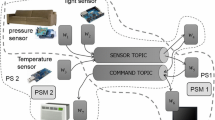Abstract
This paper presents a process calculus framework for modeling ubiquitous computing systems and dynamic component-based structures as location graphs. A key aspect of the framework is its ability to model nested locations with sharing, while allowing the dynamic reconfiguration of the location graph, and the dynamic update of located processes.
Access this chapter
Tax calculation will be finalised at checkout
Purchases are for personal use only
Similar content being viewed by others
Notes
- 1.
The CAB model is defined in [13] with an additional rule of evolution featuring silent actions. For simplicity, we have not included such a rule in our presentation here, but the stated results still stand for the CAB model presented in this paper.
- 2.
Notice that the database location does not run inside any virtual machine. This means that, at this level of abstraction, our process architectural view of the database composite is similar to a network connecting the components placed in the two virtual machines.
References
Baier, C., Sirjani, M., Arbab, F., Rutten, J.J.M.M.: Modeling component connectors in reo by constraint automata. Sci. Comput. Program. 61(2), 75–113 (2006)
Barbier, F., Henderson-Sellers, B., Le Parc, A., Bruel, J.M.: Formalization of the whole-part relationship in the unified modeling language. IEEE Trans. Softw. Eng. 29(5), 459–470 (2003)
Bengtson, J., Johansson, M., Parrow, J., Victor, B.: Psi-calculi: a framework for mobile processes with nominal data and logic. Logical Meth. Comput. Sci. 7(1) (2011)
Bliudze, S., Sifakis, J.: A notion of glue expressiveness for component-based systems. In: van Breugel, F., Chechik, M. (eds.) CONCUR 2008. LNCS, vol. 5201, pp. 508–522. Springer, Heidelberg (2008)
Bol, R.N., Groote, J.F.: The meaning of negative premises in transition system specifications. J. ACM 43(5), 863–914 (1996)
Bugliesi, M., Castagna, G., Crafa, S.: Access control for mobile agents: the calculus of boxed ambients. ACM Trans. Prog. Lang. Syst. 26(1), 57–124 (2004)
Cardelli, L., Gordon, A.: Mobile ambients. Theor. Comput. Sci. 240(1), 177–213 (2000)
Cattani, G.L., Sewell, P.: Models for name-passing processes: interleaving and causal. Inf. Comput. 190(2), 136–178 (2004)
Cleaveland, R., Lüttgen, G., Natarajan, V.: Priority in process algebra. In: Handbook of Process Algebra. Elsevier (2001)
Davey, B.A., Priestley, H.A.: Introduction to Lattices and Order, 2nd edn. Cambridge University Press, New York (2002)
David, P.C., Ledoux, T., Léger, M., Coupaye, T.: Fpath and fscript: language support for navigation and reliable reconfiguration of fractal architectures. Ann. Telecommun. 64(1–2), 45–63 (2009)
De Nicola, R., Loreti, M., Pugliese, R., Tiezzi, F.: A formal approach to autonomic systems programming: the SCEL language. ACM Trans. Auton. Adapt. Syst. 9(2), 7:1–7:29 (2014)
Di Giusto, C., Stefani, J.-B.: Revisiting glue expressiveness in component-based systems. In: De Meuter, W., Roman, G.-C. (eds.) COORDINATION 2011. LNCS, vol. 6721, pp. 16–30. Springer, Heidelberg (2011)
Ferrari, G.-L., Hirsch, D., Lanese, I., Montanari, U., Tuosto, E.: Synchronised hyperedge replacement as a model for service oriented computing. In: de Boer, F.S., Bonsangue, M.M., Graf, S., de Roever, W.-P. (eds.) FMCO 2005. LNCS, vol. 4111, pp. 22–43. Springer, Heidelberg (2006)
Fiadeiro, J.L., Lopes, A.: A model for dynamic reconfiguration in service-oriented architectures. Softw. Syst. Model. 12(2), 349–367 (2013)
Hirschkoff, D., Hirschowitz, T., Pous, D., Schmitt, A., Stefani, J.-B.: Component-oriented programming with sharing: containment is not ownership. In: Glück, R., Lowry, M. (eds.) GPCE 2005. LNCS, vol. 3676, pp. 389–404. Springer, Heidelberg (2005)
Kruchten, P.: Architectural blueprints - the 4+1 view model of software architecture. IEEE Softw. 12(6), 42–50 (1995)
Lanese, I., Montanari, U.: Mapping fusion and synchronized hyperedge replacement into logic programming. Theory Pract. Logic Program. 7(1–2), 123–151 (2007)
Lenglet, S., Schmitt, A., Stefani, J.B.: Characterizing contextual equivalence in calculi with passivation. Inf. Comput. 209(11), 1390–1433 (2011)
Milner, R.: The Space and Motion of Communicating Agents. Cambridge University Press, New York (2009)
Mousavi, M.R., Reniers, M.A., Groote, J.F.: SOS formats and meta-theory: 20 years after. Theor. Comput. Sci. 373(3), 238–272 (2007)
Oquendo, F.: \(\pi \)-ADL: an architecture description language based on the higher-order \(\pi \)-calculus for specifying dynamic and mobile software architectures. ACM Softw. Eng. Notes 29(4), 1–14 (2004)
Przymusinski, T.C.: The well-founded semantics coincides with the three-valued stable semantics. Fundamenta Informaticae 13, 445–464 (1990)
Sangiorgi, D., Walker, D.: The \(\pi \)-calculus: A Theory of Mobile Processes. Cambridge University Press, New York (2001)
Schmitt, A., Stefani, J.-B.: The kell calculus: a family of higher-order distributed process calculi. In: Priami, C., Quaglia, P. (eds.) GC 2004. LNCS, vol. 3267, pp. 146–178. Springer, Heidelberg (2005)
Tripakis, S., Stergiou, C., Shaver, C., Lee, E.A.: A modular formal semantics for ptolemy. Math. Struct. Comput. Sci. 23(4), 834–881 (2013)
van Glabbeek, R.J.: The meaning of negative premises in transition system specifications II. J. Log. Algebr. Program. 60–61, 229–258 (2004)
Wermelinger, M., Fiadeiro, J.L.: A graph transformation approach to software architecture reconfiguration. Sci. Comput. Program. 44(2), 133–155 (2002)
Ackowledgements
Damien Pous suggested the move to an early style semantics. The paper was much improved thanks to comments by Ivan Lanese on earlier versions.
Author information
Authors and Affiliations
Corresponding author
Editor information
Editors and Affiliations
Rights and permissions
Copyright information
© 2015 Springer International Publishing Switzerland
About this paper
Cite this paper
Stefani, JB. (2015). Components as Location Graphs. In: Lanese, I., Madelaine, E. (eds) Formal Aspects of Component Software. FACS 2014. Lecture Notes in Computer Science(), vol 8997. Springer, Cham. https://doi.org/10.1007/978-3-319-15317-9_1
Download citation
DOI: https://doi.org/10.1007/978-3-319-15317-9_1
Published:
Publisher Name: Springer, Cham
Print ISBN: 978-3-319-15316-2
Online ISBN: 978-3-319-15317-9
eBook Packages: Computer ScienceComputer Science (R0)




